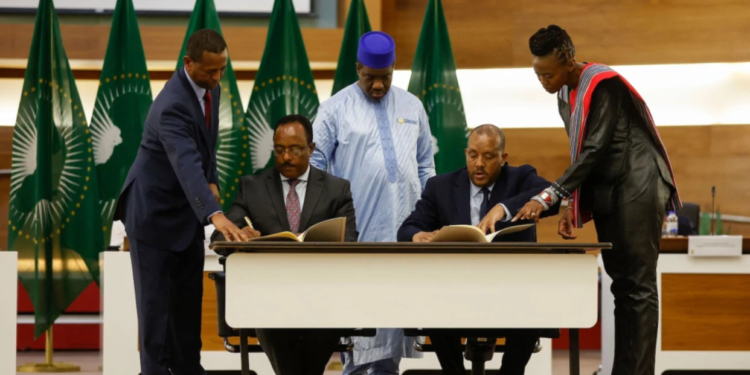The peace deal that ended the fighting between Ethiopian government forces and Tigray rebels was as welcome as it was unexpected.
It brought to an end a two-year conflict that has caused great suffering, especially to the ordinary people of the province of Tigray in northern Ethiopia, the main theatre of the conflict. Apart from attacks by government forces aided by troops from neighbouring Eritrea as well as militia groups from Amhara, the Tigrayan people had to contend with hunger and disease as the state blocked humanitarian assistance from the region. This was one of the areas that featured prominently in the African Union-brokered peace deal that was signed in Pretoria, South Africa, on November 2, 2022.
Opinion is divided on the nature of the peace deal between the government of Ethiopia and the Tigray People’s Liberation Front (TPLF) and whether it will hold.
There have also been concerns about whether the agreement is being implemented as envisaged. Even though Ethiopian Prime Minister Abiy Ahmed recently attended the US-African Summit to promote the agreement, there are conflicting reports about whether full, uninterrupted, and unfettered humanitarian aid has been allowed to return to Tigray. According to the UN Office for the Coordination of Humanitarian Affairs (OCHA), humanitarian operations continue to improve in northern Ethiopia. At least 20 of its partners reported delivering tonnes of food and non-food supplies, including health supplies, sent by road.
Humanitarian flights for staff resumed for Mekelle and started for Shire airport and much-needed medical supplies have been airlifted.
The government had committed to allowing the return of humanitarian assistance to the people of Tigray with the help of humanitarian agencies. During the conflict, the elderly, children, and women had to contend with little food and minimal access to basic needs since June 2021, when the Ethiopian government cut off essential services. The restrictions on humanitarian aid prompted UN investigators to conclude that the Ethiopian government could have used starvation as a method of war.
The agreement required Ethiopia’s federal government to restore basic services to Tigray.
OCHA said that basic services such as electricity and telecoms have been returned to key parts of Tigray, but most areas are still cut off from the world.
You May Also Like: Cartoons and justice: An Interview with Tanzania’s FeDe
Tigray has been mostly without telephone, internet, and banking services as the war raged. Power has still been disrupted in the region with a population of seven million people.
Telecommunications have resumed in some parts of southern Tigray and in the country’s second-largest region, Shire, which hosts large numbers of displaced people. Electricity supply remains erratic in Mekelle, the capital of Tigray.
Both parties agreed to the return of all displaced persons and refugees in due time.
The OCHA report says progress has been made in scaling up response to the conflict-affected Afar and Amhara regions to reach all displaced and returnee populations. Food and supplementary feeding supplies have been delivered to newly accessible areas.
With the assistance of humanitarian agencies, the government is said to be working to assist in the return of displaced people while offering protection to civilians, especially the displaced.
The Ethiopian government and the TPLF agreed to a “permanent cessation of hostilities”. However, the Tigray leaders are yet to demobilise their forces. Tigray’s top military commander, Tedasse Woreda, on December 4, 2022, told reporters that 65 per cent of his fighters had withdrawn from front-line areas.
The region’s leadership has said it will not fully demobilise until the Eritrea military withdraws.
The federal government and TPLF agreed to the cessation of overt and covert acts of violence and hostile propaganda, rhetoric, and hate speech.
They did not only agree to respect the constitution of the Federal Democratic Republic of Ethiopia but also fundamental human rights, including protecting civilians and ensuring accountability, in accordance with the constitution and the AU Transnational Policy Framework.
The leaders of Tigray and Ethiopia committed to respecting the constitutional authority of the federal government and ceasing all attempts of bringing about an unconstitutional change of government. The federal government also agreed to ensure equal representation of both the Tigrayan and Ethiopian representatives in federal institutions, including the parliament. They agreed to the restoration of Ethiopia’s federal government in Tigray.
The agreement covered the protection of civilians, especially the millions of people who were displaced during the two-year war. It also stipulated an end to sexual and gender-based violence and violence against children, and the elderly, as well as the recruitment of child soldiers.
The Ethiopian government agreed to stop military operations targeting TPLF and restore essential services in the region and also to lift the “terrorist” designation on TPLF’s fighters.
The agreement stipulated that both parties reject violence as a method of resolving political differences by agreeing to “orderly, smooth and coordinated disarmament’ and restoration of law and order. They both agreed and recognised that the Federal Republic of Ethiopia has “only one defence force”.
On November 4, 2020, the TPLF attacked the Ethiopian Defence Forces garrison in Tigray. In response, Prime Minister Abiy ordered what was labelled a “law and order action” to push the alleged impunity of TPLF. The war raged devastatingly for two years, affecting some of the country’s neighbours such as Eritrea and Sudan, which also, directly and indirectly, participated in the conflict, with all the countries in the Horn of Africa feeling the implications indirectly by the social, economic, and political fallout.
It is estimated that no fewer than 600,000 people dead either in battle or as a result of disease and lack of access to humanitarian aid. Destruction of lives directly and indirectly in other parts of Ethiopia, particularly Amhara, Afar, and Oromia, added to the estimated number of total lives lost in the Ethiopian civil war to a million.







